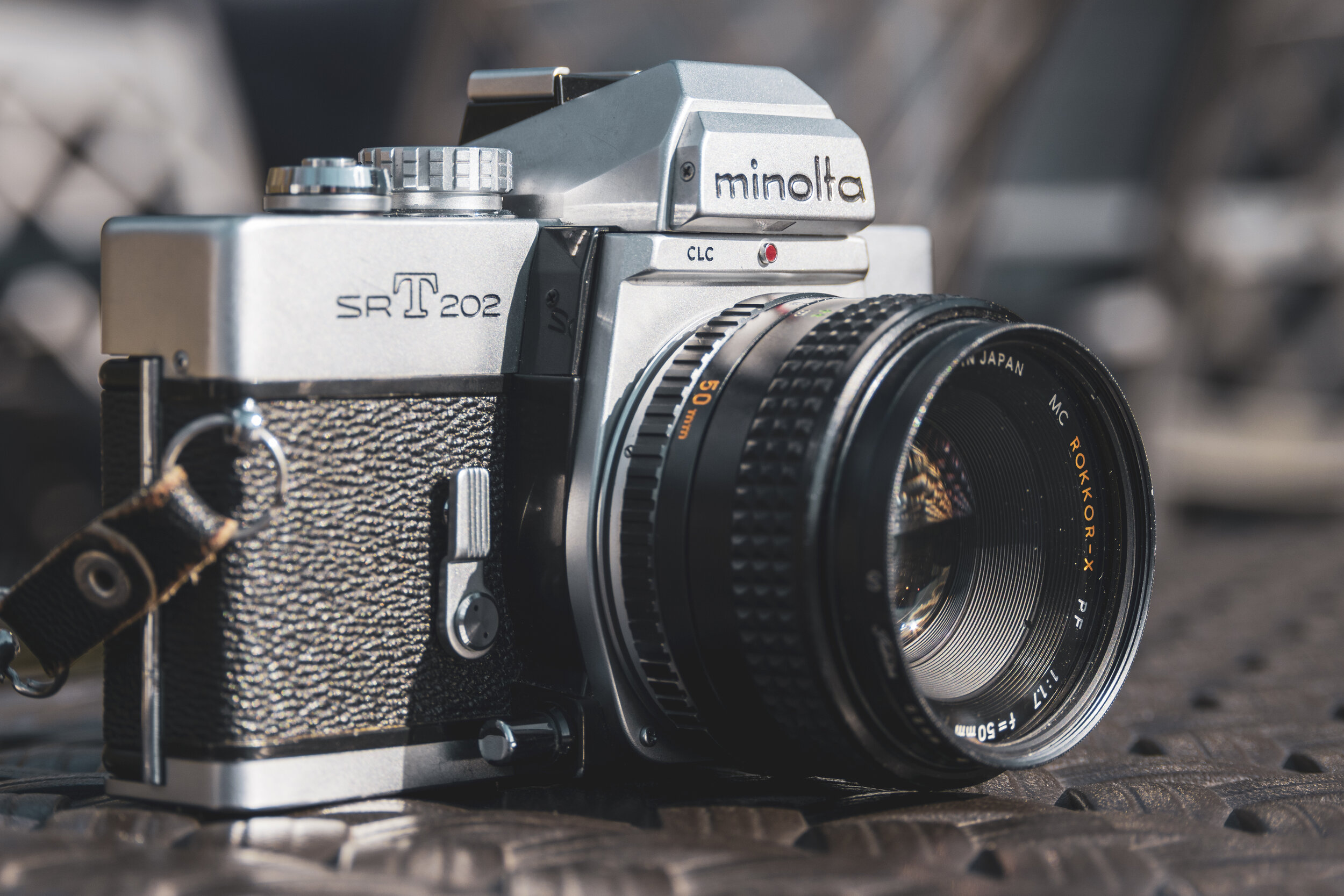All About the Minolta SrT-202
Written and Photographed by Nick Chismar
Introduction
Minolta was once one of the leading camera makers in the world, blazing trails through their collaborations with Ernst Leitz (Leica) and other developments throughout the 20th Century. One of their most famous cameras was the SrT-101, a fully mechanical SLR with the world’s first matrix metering system which Minolta Called “Contrast Light Compensator” or CLC Metering.
The SrT-101 became an instant sensation when it was released in April of 1966 and remained in production for nearly ten years. Minolta was continuously improving, with new models and changes being made across the board. In 1975 the SrT line reached its pinnacle with the SrT-202.
The SrT-202
The SrT-202 was built upon the SrT-102 which was the top of the line camera for Minolta at the time. A fully metal body gave the camera a solid feeling like the rest of the line. The SrT-202 brought some changes however, ditching the mirror lock up feature while retaining the depth of field preview. It also gained a safe load indicator. This simple window would show an orange bar when film was correctly loaded onto the take-up spool so photographers wouldn’t have to find out later they never advanced the film. A minor change was the addition of a memo holder around the ASA/DIN chart on the back of the camera.
In the field
My SrT-202 was purchased by my father around 1976 and has been in near constant use ever since. Over its 44 years of service it has documented family get togethers, vacations, and other events throughout our lives. It’s constant use however ended when it was put away around 2006 with a roll of film still inside of it. The camera was left untouched in its bag for a little over 12 years until I had to break it out for a film course, and since then it really hasn’t gone a week without shooting a roll.
The best way to describe the SrT-202 is simply by calling it a tank. Since it is fully mechanical, the battery only powers the lightmeter and match stick display, so in the case the battery dies or you’re stuck in freezing conditions the camera will still work, provided you have something to meter with. The on/off/batter check switch is located on the bottom.
Much like the other champions of the film age, the SrT-202 is very simple to use. Loading is like any camera, and all of the controls are within reach of the user. The advance lever is smooth but requires a little force since you are winding the shutter as well. The shutter is a horizontally traveling cloth shutter which is quiet compared to some cameras of the age, but still lets people know you’re taking a picture.
In the viewfinder, you will find everything you need. At the top center is the aperture display, showing what f-stop you have selected on the lens. To the right is the matchstick meter display, with a battery checkbox toward the bottom and one arrow at the top and bottom to display the usual “working range” of the camera, though I have pushed the meter beyond these at times. Across the bottom is your shutter speed display, once again showing what speed you have selected to use. All of this is relatively bright and very legible, though it can be difficult to read at night or in dimly lit situations.
All in all the SrT-202 is an incredible camera, built to the high standard Minolta was known for. One of the best parts is the lens mount, Minolta’s SR bayonet system for the MD and later MC lenses. This gives you a nearly unlimited amount of glass to choose from including Minolta’s legendary Rokkor line. All of the images in this article were taken with my Rokkor-X PG 50mm f1.4 adapted to my Nikon D3300. To say that this lens is sharp is an understatement.
So if you're in the market for a manual SLR give the SrT line a try or just go for a 202 right off the bat. After 44 years of use and no servicing this tank is still going through rolls like new, and shows no signs of stopping.
Additional Specifications
Type
Single Lens Reflex
CLC through the lens matrix metering
Meter sensitivity of EV 3 to EV17 at ISO 100
Shutter
Fully mechanical cloth focal plane
Speeds from 1-1/1000 of a second plus B
Shutter Speed of 1-1/60 of a second with flash
Features
Oversized quick return mirror
Matchstick exposure control needle, aperture, and shutter speed readouts
Both Split image and microprism band focusing
Flash sync for X and FP with hotshoe
Film safe load indicator
Frame reset counter with automatic reset when the back is opened
Self timer
Depth of Field preview button
Film memo holder
Sample Images
To see sample images taken with the Minolta SrT-202, check out Nick’s other articles!
If you enjoyed this article, feel free to check out our Film-Focused YouTube Channel!












